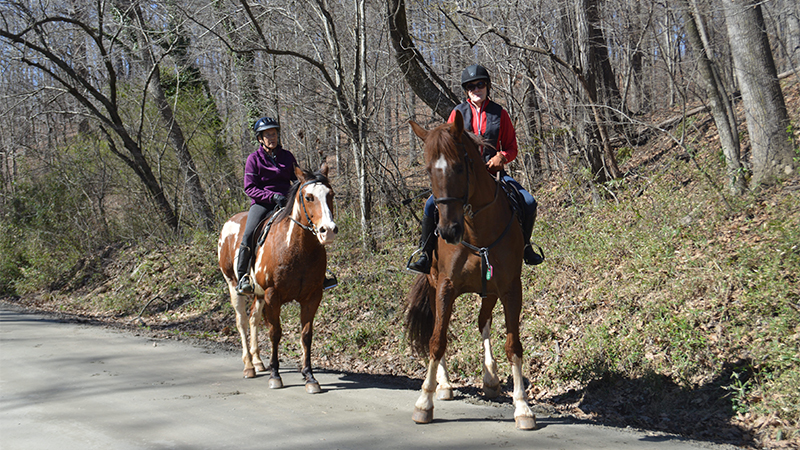‘Our Changing Equestrian Landscape’
Published 8:00 am Friday, March 2, 2018

- Sandy Rhodes and Anne McIver and their horses, Scout and Simon, are just two of the many equestrians who enjoy the wonderful trails and other riding opportunities in the Foothills area. More than 85 people attended Tuesday’s symposium, “Our Changing Equestrian Landscape,” at the Foothills Equestrian Nature Center to discuss ways to preserve the land for the continuation of the area’s equestrian lifestyle. (Photo by Catherine Hunter)
Panel discusses ways to preserve the area’s equestrian lifestyle
TRYON — “If we don’t do something now, we’ll wind up like Wellington or Southern California,” said Elizabeth “Dibbit” Lamb. “We’ll have horses living in 20-foot-by-50-foot sand lots.”
Lamb organized Tuesday’s symposium, “Our Changing Equestrian Landscape.” More than 85 concerned equestrians and landowners attended the conference at the Foothills Equestrian Nature Center to discuss ideas about land conservation in the area.
“The equestrian tradition here makes this area unique,” said David Twiggs, executive director of the Masters of Foxhounds Association.
Twiggs served as keynote speaker for the symposium, and said that the Masters of Foxhounds Association acts as a catalyst and partners with local landowners, concerned citizens and officials to impact local areas.
Twiggs spoke about communities finding a balance between different lifestyles, such as farms, cluster developments, affordable housing and open spaces for foxhunting and horse keeping. He said the area has a good dynamic, blending the old colony hunt country that has been here for a hundred years and the new development of the Tryon International Equestrian Center.
“This is not a place for cul-de-sacs and urban sprawl,” Twiggs said. “It’s about making a balanced community.”
Lamb, who has been with Conserving Carolina since it was the Pacolet Area Conservancy, and now serves as the nonprofit’s secretary, said now is the time to act.
“By the time you see the chainsaws and bulldozers, it’s too late,” she said.
Lamb said the purpose of the symposium was to educate people about the issue. She said for the last 10 years the area has had little development because of the economy.
“Development is coming now,” she said. “We must take action now.”
Ways to help preserve the Foothills equestrian tradition, available land resources
During the February “Our Changing Equestrian Landscape” symposium, area county officials, landowners, conservation specialists and concerned equestrians gathered to discuss ways to preserve the Foothills equestrian traditions through the available land resources.
Ways in which residents can help protect available lands for equestrian activities include:
• Attending planning commission meetings and letting their voice be heard
• Set up private trail systems with a few neighbors
• Plan for trial maintenance and put all agreements in writing
• Set up trail protection easements, and put these easements in writing
• Create liability protection for landowners
• Create reasonable usage rules and be accountable to landowners
• Educate landowners and riders about best practices to protect trails from fence setbacks, erosion control, stream crossings and compatible uses.
• Partner with federal, state and local agencies to enhance wildlife habitats, protect water quality and other land quality benefits.
• Support farmers in developing long-term plans to ensure financial security and protection for their lands.
• Consider leasing land to beginning farmers





